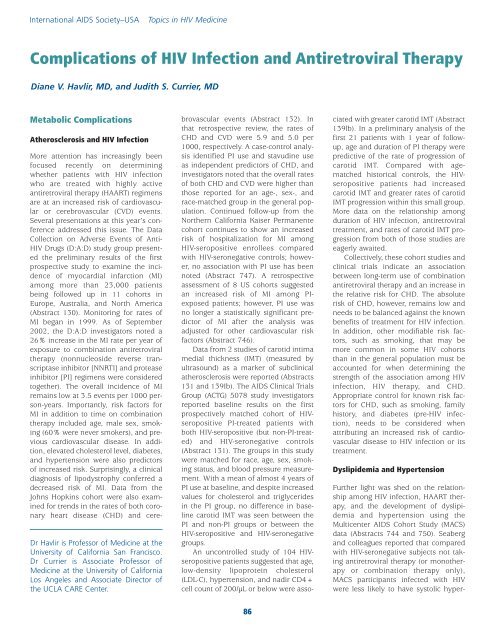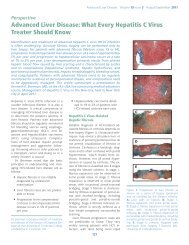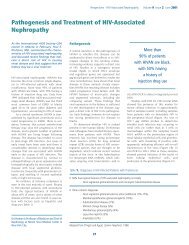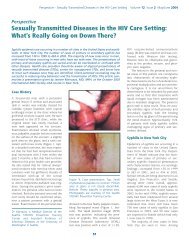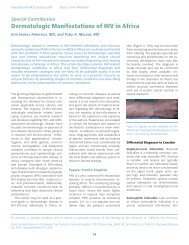Topics in HIV Medicine® - International AIDS Society-USA
Topics in HIV Medicine® - International AIDS Society-USA
Topics in HIV Medicine® - International AIDS Society-USA
You also want an ePaper? Increase the reach of your titles
YUMPU automatically turns print PDFs into web optimized ePapers that Google loves.
<strong>International</strong> <strong>AIDS</strong> <strong>Society</strong>–<strong>USA</strong><br />
<strong>Topics</strong> <strong>in</strong> <strong>HIV</strong> Medic<strong>in</strong>e<br />
Complications of <strong>HIV</strong> Infection and Antiretroviral Therapy<br />
Diane V. Havlir, MD, and Judith S. Currier, MD<br />
Metabolic Complications<br />
Atherosclerosis and <strong>HIV</strong> Infection<br />
Dr Havlir is Professor of Medic<strong>in</strong>e at the<br />
University of California San Francisco.<br />
Dr Currier is Associate Professor of<br />
Medic<strong>in</strong>e at the University of California<br />
Los Angeles and Associate Director of<br />
the UCLA CARE Center.<br />
More attention has <strong>in</strong>creas<strong>in</strong>gly been<br />
focused recently on determ<strong>in</strong><strong>in</strong>g<br />
whether patients with <strong>HIV</strong> <strong>in</strong>fection<br />
who are treated with highly active<br />
antiretroviral therapy (HAART) regimens<br />
are at an <strong>in</strong>creased risk of cardiovascular<br />
or cerebrovascular (CVD) events.<br />
Several presentations at this year’s conference<br />
addressed this issue. The Data<br />
Collection on Adverse Events of Anti-<br />
<strong>HIV</strong> Drugs (D:A:D) study group presented<br />
the prelim<strong>in</strong>ary results of the first<br />
prospective study to exam<strong>in</strong>e the <strong>in</strong>cidence<br />
of myocardial <strong>in</strong>farction (MI)<br />
among more than 23,000 patients<br />
be<strong>in</strong>g followed up <strong>in</strong> 11 cohorts <strong>in</strong><br />
Europe, Australia, and North America<br />
(Abstract 130). Monitor<strong>in</strong>g for rates of<br />
MI began <strong>in</strong> 1999. As of September<br />
2002, the D:A:D <strong>in</strong>vestigators noted a<br />
26% <strong>in</strong>crease <strong>in</strong> the MI rate per year of<br />
exposure to comb<strong>in</strong>ation antiretroviral<br />
therapy (nonnucleoside reverse transcriptase<br />
<strong>in</strong>hibitor [NNRTI] and protease<br />
<strong>in</strong>hibitor [PI] regimens were considered<br />
together). The overall <strong>in</strong>cidence of MI<br />
rema<strong>in</strong>s low at 3.5 events per 1000 person-years.<br />
Importantly, risk factors for<br />
MI <strong>in</strong> addition to time on comb<strong>in</strong>ation<br />
therapy <strong>in</strong>cluded age, male sex, smok<strong>in</strong>g<br />
(60% were never smokers), and previous<br />
cardiovascular disease. In addition,<br />
elevated cholesterol level, diabetes,<br />
and hypertension were also predictors<br />
of <strong>in</strong>creased risk. Surpris<strong>in</strong>gly, a cl<strong>in</strong>ical<br />
diagnosis of lipodystrophy conferred a<br />
decreased risk of MI. Data from the<br />
Johns Hopk<strong>in</strong>s cohort were also exam<strong>in</strong>ed<br />
for trends <strong>in</strong> the rates of both coronary<br />
heart disease (CHD) and cerebrovascular<br />
events (Abstract 132). In<br />
that retrospective review, the rates of<br />
CHD and CVD were 5.9 and 5.0 per<br />
1000, respectively. A case-control analysis<br />
identified PI use and stavud<strong>in</strong>e use<br />
as <strong>in</strong>dependent predictors of CHD, and<br />
<strong>in</strong>vestigators noted that the overall rates<br />
of both CHD and CVD were higher than<br />
those reported for an age-, sex-, and<br />
race-matched group <strong>in</strong> the general population.<br />
Cont<strong>in</strong>ued follow-up from the<br />
Northern California Kaiser Permanente<br />
cohort cont<strong>in</strong>ues to show an <strong>in</strong>creased<br />
risk of hospitalization for MI among<br />
<strong>HIV</strong>-seropositive enrollees compared<br />
with <strong>HIV</strong>-seronegative controls; however,<br />
no association with PI use has been<br />
noted (Abstract 747). A retrospective<br />
assessment of 8 US cohorts suggested<br />
an <strong>in</strong>creased risk of MI among PIexposed<br />
patients; however, PI use was<br />
no longer a statistically significant predictor<br />
of MI after the analysis was<br />
adjusted for other cardiovascular risk<br />
factors (Abstract 746).<br />
Data from 2 studies of carotid <strong>in</strong>tima<br />
medial thickness (IMT) (measured by<br />
ultrasound) as a marker of subcl<strong>in</strong>ical<br />
atherosclerosis were reported (Abstracts<br />
131 and 139Ib). The <strong>AIDS</strong> Cl<strong>in</strong>ical Trials<br />
Group (ACTG) 5078 study <strong>in</strong>vestigators<br />
reported basel<strong>in</strong>e results on the first<br />
prospectively matched cohort of <strong>HIV</strong>seropositive<br />
PI-treated patients with<br />
both <strong>HIV</strong>-seropositive (but non-PI-treated)<br />
and <strong>HIV</strong>-seronegative controls<br />
(Abstract 131). The groups <strong>in</strong> this study<br />
were matched for race, age, sex, smok<strong>in</strong>g<br />
status, and blood pressure measurement.<br />
With a mean of almost 4 years of<br />
PI use at basel<strong>in</strong>e, and despite <strong>in</strong>creased<br />
values for cholesterol and triglycerides<br />
<strong>in</strong> the PI group, no difference <strong>in</strong> basel<strong>in</strong>e<br />
carotid IMT was seen between the<br />
PI and non-PI groups or between the<br />
<strong>HIV</strong>-seropositive and <strong>HIV</strong>-seronegative<br />
groups.<br />
An uncontrolled study of 104 <strong>HIV</strong>seropositive<br />
patients suggested that age,<br />
low-density lipoprote<strong>in</strong> cholesterol<br />
(LDL-C), hypertension, and nadir CD4+<br />
cell count of 200/µL or below were associated<br />
with greater carotid IMT (Abstract<br />
139lb). In a prelim<strong>in</strong>ary analysis of the<br />
first 21 patients with 1 year of followup,<br />
age and duration of PI therapy were<br />
predictive of the rate of progression of<br />
carotid IMT. Compared with agematched<br />
historical controls, the <strong>HIV</strong>seropositive<br />
patients had <strong>in</strong>creased<br />
carotid IMT and greater rates of carotid<br />
IMT progression with<strong>in</strong> this small group.<br />
More data on the relationship among<br />
duration of <strong>HIV</strong> <strong>in</strong>fection, antiretroviral<br />
treatment, and rates of carotid IMT progression<br />
from both of those studies are<br />
eagerly awaited.<br />
Collectively, these cohort studies and<br />
cl<strong>in</strong>ical trials <strong>in</strong>dicate an association<br />
between long-term use of comb<strong>in</strong>ation<br />
antiretroviral therapy and an <strong>in</strong>crease <strong>in</strong><br />
the relative risk for CHD. The absolute<br />
risk of CHD, however, rema<strong>in</strong>s low and<br />
needs to be balanced aga<strong>in</strong>st the known<br />
benefits of treatment for <strong>HIV</strong> <strong>in</strong>fection.<br />
In addition, other modifiable risk factors,<br />
such as smok<strong>in</strong>g, that may be<br />
more common <strong>in</strong> some <strong>HIV</strong> cohorts<br />
than <strong>in</strong> the general population must be<br />
accounted for when determ<strong>in</strong><strong>in</strong>g the<br />
strength of the association among <strong>HIV</strong><br />
<strong>in</strong>fection, <strong>HIV</strong> therapy, and CHD.<br />
Appropriate control for known risk factors<br />
for CHD, such as smok<strong>in</strong>g, family<br />
history, and diabetes (pre-<strong>HIV</strong> <strong>in</strong>fection),<br />
needs to be considered when<br />
attribut<strong>in</strong>g an <strong>in</strong>creased risk of cardiovascular<br />
disease to <strong>HIV</strong> <strong>in</strong>fection or its<br />
treatment.<br />
Dyslipidemia and Hypertension<br />
Further light was shed on the relationship<br />
among <strong>HIV</strong> <strong>in</strong>fection, HAART therapy,<br />
and the development of dyslipidemia<br />
and hypertension us<strong>in</strong>g the<br />
Multicenter <strong>AIDS</strong> Cohort Study (MACS)<br />
data (Abstracts 744 and 750). Seaberg<br />
and colleagues reported that compared<br />
with <strong>HIV</strong>-seronegative subjects not tak<strong>in</strong>g<br />
antiretroviral therapy (or monotherapy<br />
or comb<strong>in</strong>ation therapy only),<br />
MACS participants <strong>in</strong>fected with <strong>HIV</strong><br />
were less likely to have systolic hyper-<br />
86


